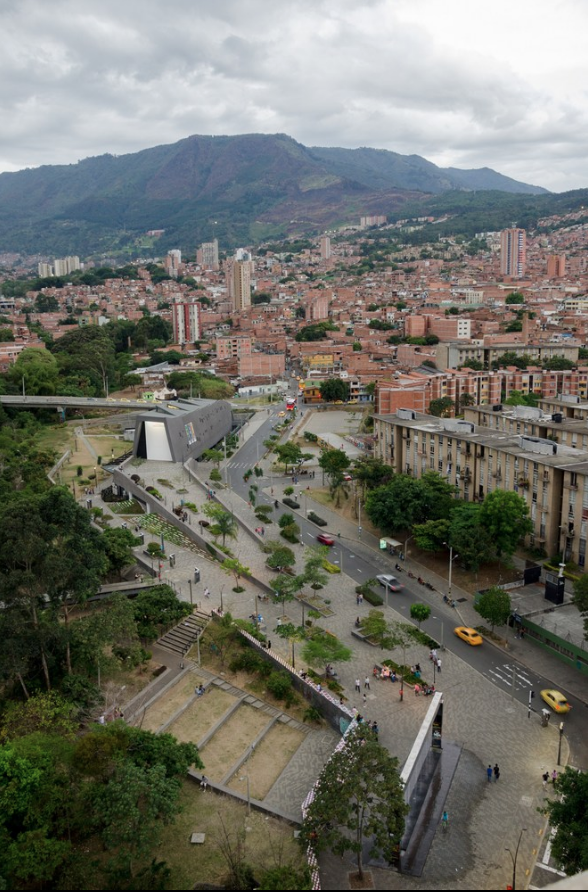
Sketches of the Museum
Source: Dezeen
Source: Dezeen
Introduction
In this project, I look at how the City of Medellín is using public space to promote peace and the preservation of memory. While other approaches to preserving memory exist in Medellín, I was particularly interested in how the Mayor’s Office has created infrastructure around memory. In Medellín, spaces of memory and memorialization have been used to “restore a sense of place to the experiences of displacement, discontinuity, and fragmentation that violence inflict on people’s lives.” Museo Casa de la Memoria (House of Memory Museum) is one example of how the city is providing such spaces.”
1
My analysis includes two parts: First, an overview of the how the museum’s design and exhibits contribute to its role in the community and second, an assessment of visitor satisfaction, both locally and abroad based on data from Tripadvisor.com. The goal of this analysis is to measure the sucess of this project in serving the community in Medellín.
Museo Casa de la Memoria
Museum plan versus the entrance of the museum today.
In 2006, Museo Casa de la
Memoria was constructed under the Victim Assistance Program of Medellin City Hall. The museum’s provides information
about the history and current state of the conflict. Free admission and central location make the museum more accessible to the public.
As part of “Parque Bicentenario,” the museum also has an environmental focus with access to green space along the Santa
Elena Creek. Parque Bicentenario was created along the Santa Elena Creek to honor Colombia’s 200 year anniversary of
independence. The museum’s location within the park - a cultural symbol of equity and independence - also contributes to its
mission of encouraging reflection on equality and peace.

Museo Casa de la Memoria and surroundingneighborhood in Medellín. Tracing along the image shows the contrast between
the museum site and the area.
Soruce: Archdaily
In 2015, a New York Times review describes the museum as,“[a] sleek oblong, it is just one of the new, visually compelling
buildings that are popping up all over the city — and often appearing somewhat incongruous in neighborhoods that have looked
the same for decades.”Soruce: Archdaily
2
The museum stands out in the neighborhood as a modern, newly built project.
The photo below shows the contrast between the modern park and museum building and surrounding Boston neighborhood of Medellín.
Renderings showing the new design of the Parque Bicentenario and Museo Casa de la Memoria
Source: Alcaldía de Medellín - Obras Publicas
Source: Alcaldía de Medellín - Obras Publicas
Memory
The design for the museum, by architects Juan David Botero and Alejandro Naranjo, is described as a series of “spaces that enable the reconstruction and dissemination of historical memory with museographic designs for exhibitions, with the aim of transforming violent events into social learning.”
3
As part of “Parque Bicentenario,” the museum also has an environmental focus with access to green space along the Santa Elena Creek.
Parque Bicentenario was created along the Santa Elena Creek to honor Colombia’s 200 year anniversary of independence. The
museum’s location within the park - a cultural symbol of equity and independence - also contributes to its mission of encouraging reflection
on equality and peace.
The museum’s exhibitions include art, archives, activities and other ways to prompt discussions surrounding the conflict. An example includes an exhibit on Grammar for peace and conflict. The exhibit description: "Grammar of peace and conflict is an invitation to reconstruct collective stories from the power of the human, interlacing narratives, lives and memories".
4
More current and upcoming exhibits here:
The website of the Museo Casa de la Memoria
Trip Advisor Data
I used data from Tripadvisor.com to gage community satisfaction with the museum as well as reviews from international tourists. Collecting Tripadvisor data, I intended to use all 135 entries for the museum. For comparison of local (within Colombia) versus international visitors, the data includes reivews that reported the origin country/city of the visitor. The reviews were used to gage the overall satisfaction that local, Colombian, and international travelers had with the museum. Many of the reviewers provide emotional responses that were overwhelmingly positive. To summarize, from the 50 reviews I collected, many tourists found the exhibits informative and powerful, while Colombians found a sense of memory and remembrance. The level of detail included in these reviews helps to show the extent to which the museum serves its purpose. The average Tripadvisor star rating (out of five) was a 4.5. The reviews included in this analysis span over the past two years.There are limitations to using Tripadvisor data. The 135 reviews - or even smaller pool that I have selected - do not represent the views of all visitors to the museum. All of the information on the site is self-reported, with certain fields being optional, such as the origin country/city. The map I have created also places more weight on local reviews and other Colombian cities because of an assumed familiarity with the specific community and national issues addressed at the museum.
Community and International Responses
See map in full screen.
A complete list of visitor reviews for the museum.
Conclusion
Based on local, national and international Tripadvisor reviews, as well as an assessment of city plans, Museo Casa de la Memoria appears to be fulfilling its vision for providing a space for memory. On the topic of memory, the museum states that "Memory is a window to Community. It contributes to recognize the place of each one of us and to understand the reality of the city and the country. Memory unites realities, allows to build collectively and is expressed by multiple languages while we recognize each other and identify us."5
The program can serve as a model for other city governments in Colombia to use in conflict mediation. Please note: footnotes not visible on mobile.
Return to Student Projects